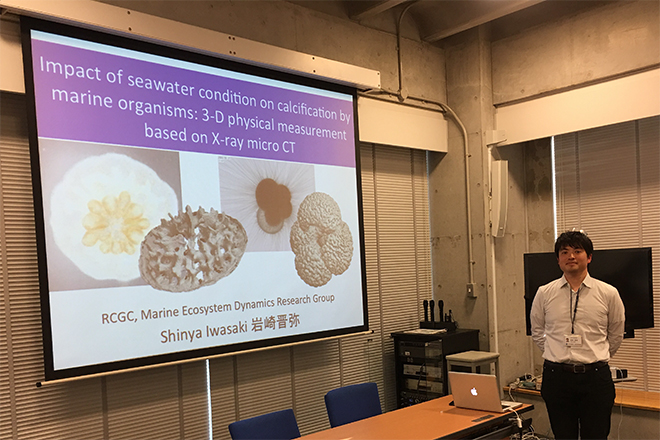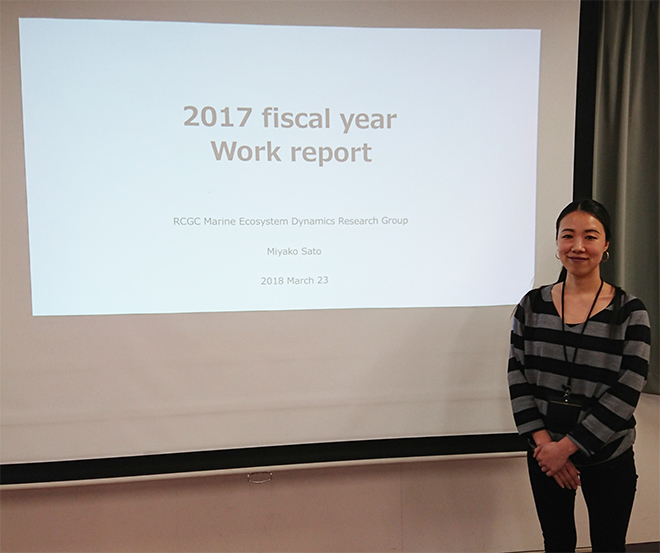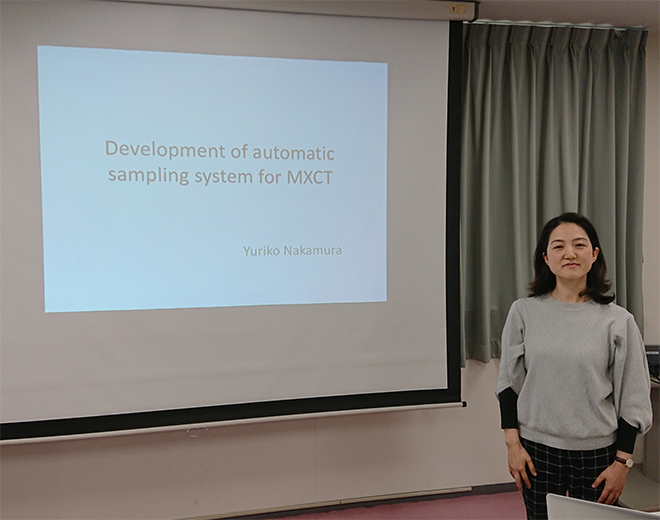We have the ecosystem group seminar at the first and third Thursday regularly for an exchange of information and views on research subject, and are publishing the abstract and part of slides used in the seminar on our website.
Schedule
* The schedule is subject to change if we have a guest speaker.
Mar 23, 2018
March 9, 2018
Maki Noguchi Aita
"Preliminary report of Hakuho-maru KH-17-5 Leg 3"
Erina Shima
"Shell density measurements of thecosomatous pteropods in the Arctic Ocean"
Abstract
Shell density of shelled pteropod Limacina helicina was examined using the Micro focus X-ray Computed Tomography. The CT numbers suggesting shell density obtained in this study tended to increase with saturation state of omega aragonite (ΩA) values of seawater sampled at 20m water depth. Besides, variations of CT number were consistent with the damages of shell surface structure observed by the Scanning electron microscope (SEM).
Feb 23, 2018
Carmen García-Comas
"Zooplankton size structure across different water-masses in the north Pacific"
Abstract
Individual size has long been acknowledged as a key functional trait for plankton community structuring through physiological and mechanical constraints, and recent field observations suggest that plankton size diversity alters trophic transfer. Furthermore, mesozooplankton size diversity has been related to nutrients and temperature. A pervasive negative relationship of temperature and body size across systems has been noticed since long time. Yet, mechanisms linking temperature and body size include direct and indirect effects in aquatic systems. Most studies have focused on the direct effect of acceleration of metabolic rates with temperature. A much less explored issue is whether mesozooplankton size diversity can be related to the vertical structure of the water column. In order to contribute to fill this knowledge gap, here, we analyse 1350 samples collected throughout the north Pacific for the period 1981-2009. Samples correspond to 150-0m vertical tows of a NORPAC net collected during summer in latitudinal transects with an average sample separation of ~ 1°. We measured mesozooplankton size in the laboratory with a bench-top OPC and computed size diversity as the analogue of the Shannon index for the community size pdfs. For ~1000 samples, T-S profiles were depicted and therefore we have information on the vertical structure of the water column. In this short presentation, I will explore the relationship of size diversity with the T-S diagrams, as well as size spectra shape with thermal vertical structure, in order to relate size structure to water mass. I will conclude with a simple idea to contribute to the understanding of size-based community structuring and serve ecosystem modeling and fisheries predictions in the North Pacific.
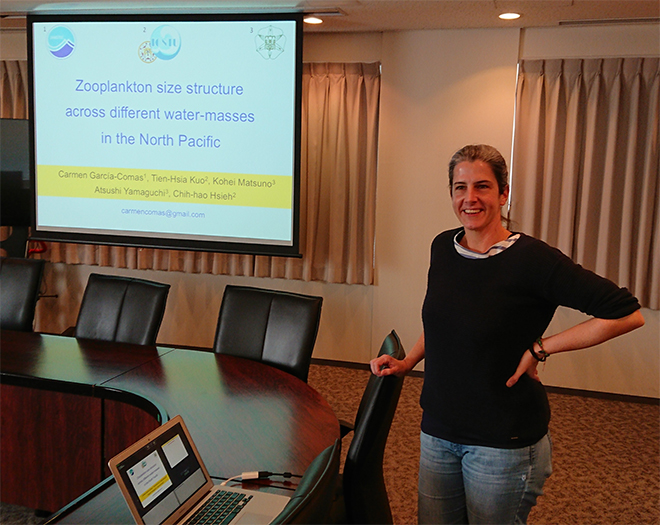
Jonaotaro Onodera
"Lateral advection of biogenic particles in the southwestern Canada Basin, Arctic Ocean"
Abstract
Intensified sea surface circulation due to sea ice reduction seems to influence the condition of material transportation from the Chukchi Sea shelf to the Canada Basin of Arctic Ocean. This physical oceanographic change influences to marine ecosystem and biogeochemical cycle. In order to observe the relationship between the changing hydrographic condition and particle transportation from sea surface and the Chukchi Sea shelf, two moorings with sediment trap and hydrographic sensors has been deployed in the southwestern Canada Basin (Station NBC: 72°28.3‘N 155°24.4’W, Station NHC: 73°18.1’N 160°47’W) since September 2015. The sediment trap samples of second annual deployment from September 2016 were obtained by R/V Mirai cruise (MR17-05C). Total mass flux of settling particles (< 1mm size) reached to 2,389 mg m-2 d-1 and 3,729 mg m-2 d-1 in 150-260 m depth at Stations NBC and NHC, respectively. The maximum of total mass flux was one order higher than the previous data in the central Canada Basin and the Northwind Abyssal Plain. The trapped particles are mainly composed of lithogenic matters (72wt% in all studied samples). Based on abundance ratio of biogenic and lithogenic matters for the low productivity season in winter, trapped biogenic matters were distinguished to reworked shelf-sediment origin and upper water-column origin in study area. The abundance ratio of two different origins shows that biogenic matters of upper water-column origin were relatively abundant in summer and contribution of shelf origin was higher in fall-winter seasons. There was the high flux period of total biogenic matters at two mooring stations from late October 2016 to January 2017. This high particle flux period corresponds to the period for temporal occurrence of Bering shelf water to 50-150 m depth at the mooring position. The settling flux of particulate organic carbon (POC) for the lateral advection event contributed 45-63% of total POC flux during the second annual deployment period.
Feb 9, 2018
Hajime Kimura
"How International law is made and work: The Case of the Svalbard Archipelago"
Abstract
The Arctic environment has changed substantially over the last almost 100 years since the Svalbard treaty was concluded. It was the first international legally binding agreement governing the Arctic. Treaty provides for Norwegian sovereignty over Svalbard, while at the same time providing for certain rights for the other signatories. Now the Treaty faces newly emerged international legal situation, which could not possibly be envisaged by the original drafters. In this short presentation, I’ll try to explain briefly how an international agreement is made and work by introducing the Svalbard treaty as an example.
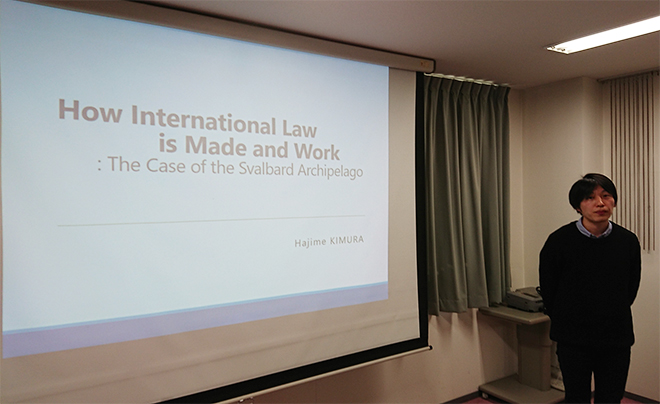
Takuhei Shiozaki
"Temporal variation in eukaryotic plankton communities in suspended and sinking particles at the subtropical station S1: a preliminary result"
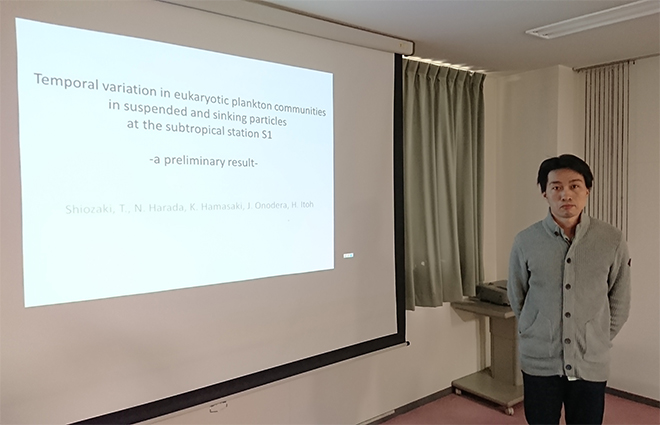
Jan 26, 2018
Bingzhang Chen
"Effect of phytoplankton size diversity on productivity in the North Pacific: a modeling study"
Abstract
Understanding the relationships between biodiversity and ecosystem functioning is critical for planning and justifying successful conservation efforts. While most studies have found a positive relationship between species richness and ecosystem functioning such as productivity, it remains unclear whether similar patterns hold for microscopic marine phytoplankton, for which “everything is everywhere, but the environment selects”. Here we use the continuous trait-based modeling approach, which assumes infinite species richness and represents diversity in terms of the trait distribution, to investigate relationships between phytoplankton size diversity and productivity in a three-dimensional ocean circulation model applied to the North Pacific. Unexpectedly, we find a slightly negative effect of size diversity on productivity, which arises because productivity saturates at low size diversity levels that can be sustained solely by three-dimensional transport and mixing, without invoking other mechanisms such as mutation or active prey switching (i.e., kill-the-winner effect). Under the conditions set by the observation-based physical forcing used for our simulations, the benefits of trait optimization, whereby narrow size (and hence trait) distributions enhance productivity under relatively stable conditions, tend to dominate over those of adaptive capacity, whereby greater diversity enhances temporal complementarity under sufficiently variable conditions.
Siri Ofstad
"Methane-induced ocean acidification and planktic foraminifera calcification"
Abstract
Methane released from the seafloor is aerobically oxidized in the water column, producing CO2. CO2 induces fundamental changes to the seawater chemistry, and a phenomenon known as Ocean Acidification. Our results show elevated bottom water dissolved inorganic carbon and decreased pH, in a location with vast methane seepage. The results also indicate an enhancement of primary production in the surface waters. Calcification intensity of the two dominant planktic foraminifera species differed from one another through-out the water column, and was not controlled by carbonate ion concentration.
Jan 12, 2018
Tetsuichi Fujiki
"Biogeochemical-Argo: brief overview and recent trend"
Abstract
One of the goals in present-day ocean biogeochemistry is to better understand the response of biological productivity to environmental changes, such as warming, acidification and deoxygenation, driven by increasing atmospheric carbon dioxide. Our primary method for ocean observations is traditional ship-based measurements. However, the number of observations made from ships is decreasing dramatically, and the ship-based studies of the open ocean are very limited in our opportunity to conduct the time-series observations. To overcome these problems, the observations made by autonomous platforms, especially by profiling floats, are rapidly increasing. Here, I present the brief overview and recent trend of biogeochemical profiling floats (BGC-Argo program).
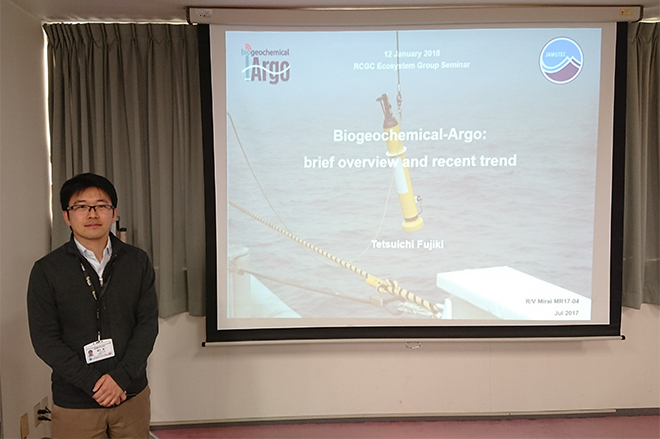
Naomi Harada
"Research Plan in FY2018"
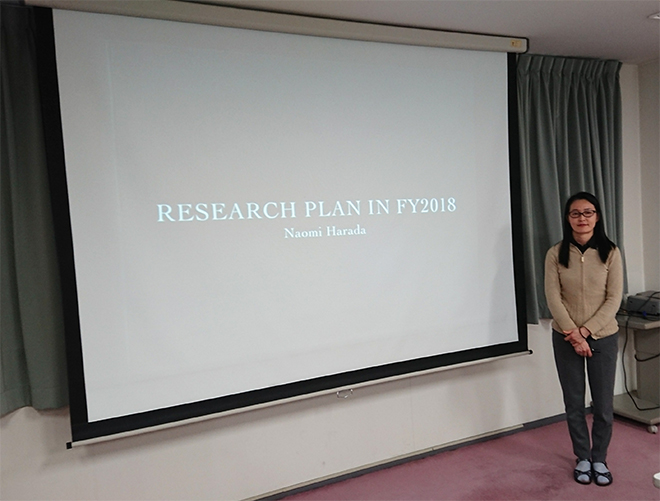
Dec 22, 2017
Koji Sugie
"Higher temperature accelerate the growth of iron-limited phytoplankton communities in the subarctic Pacific"
Abstract
Iron is one of the key element determining the carrying capacity of primary production in the marine ecosystem. Because of iron scarcity in certain oceanic regions, phytoplankton communities were dominated by small-sized non-diatom species and thus less efficient trophic transfer and biological carbon pump. However, the effect of climate change such as warming on iron-limited phytoplankton is poorly investigated. This study investigated that the effect of higher temperature (+ 4–5°C relative to controls) and iron addition on the growth dynamics of phytoplankton communities in the subarctic Pacific. Two experiments were conducted during summer in 2014 aboard R/V Mirai (MR14W: 47°N, 160°E; MR14E: 47°N, 148°W) and another one experiment was conducted during late winter in 2015 aboard R/V Hakuho-Maru (KH15: 42°N, 146°E). The addition of iron enhanced the specific growth rate of larger phytoplankton groups in all three experiments whereas smaller phytoplankton groups were rarely affected. In MR14W and KH15 experiments, higher temperature enhanced the growth of phytoplankton in both unamended controls and iron-added treatments. The magnitude of growth enhancement by the temperature increases was larger in smaller phytoplankton groups relative to the larger groups in the KH15 experiment. According to the relative growth rate analysis (between higher temperature (+ 4–5°C) treatment to control temperature under each iron conditions, and between iron-added to non-iron-added treatment under each temperature conditions), we found that the summer phytoplankton communities were iron-limited rather than temperature-limited whereas late winter phytoplankton community was temperature-limited rather than iron-limited. Our results suggest that the temperature conditions could modify the dynamics of iron-limited phytoplankton communities, especially for the low-temperature conditions. In addition, future global warming may enhance the growth of phytoplankton even in the iron-limited open ocean. Given the higher temperature could enhance the growth of smaller phytoplankton groups relative to the larger ones as observed in the KH15 experiment, not only climate change but also seasonal warming from winter to summer may play a key role in the dynamics of community composition in the ocean.
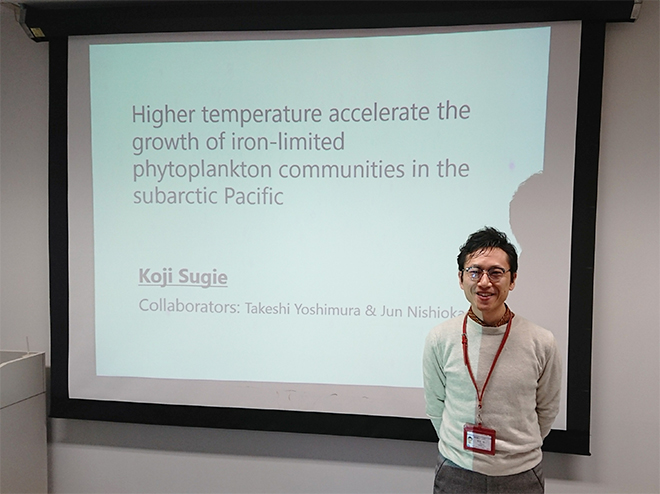
Dec 8, 2017
Tasuku Akagi (Department of Earth and Planetary Sciences, Kyushu University)
"Ocean weathering: the novel role oceanic diatoms play in the elemental cycling"
Abstract
It is shown that diatom frustules may play an important role in material cycling in the oceans: Diatoms may disintegrate silicate minerals and incorporate elements in the minerals into their frustules.
Disintegration of silicate minerals by diatoms is referred to as “ocean weathering”. Admitting the new role leads to the following radical propositions. i) Elements in terrigenous matter may enter the oceanic system largely via diatom frustules; ii) Diatom frustules could be major vertical transporters for some elements; iii) Diatoms may act as filters to determine elements to be buried as silicate complexes on the seafloor.
The topics and brief summaries of the talk are
1) Evidence for the new role of diatoms
Evidence for the new role has been collected using rare earth elements (REEs) and aluminum. Our studies using REEs imply their extra supply to diatom frustules from the ocean surface, which cannot be explained by dissolved REEs. The state of more than 90% of Al in the settling particles is shown to be different from that of Al in terrigenous silicate minerals or Al adsorbed on opal, suggesting that Al is vertically transported as a constituent of frustules.
2) The composition of diatom frustules and behavior of the elements in frustules
The composition of diatom frustules, which is estimated using the dissolution kinetics of diatom aggregates, implies that frustules contain terrigenous elements at high concentrations, but it is yet distinct from that of the terrigenous end-members. The behavior of the elements in diatom frustules would be dependent, to the first approximation, on the chemistry of metallo-silica complexes.
3) Implication for the glacial-interglacial cycle
If time is allowed, the entirely new explanation will be given to the Nd isotope record of manganese crusts in terms of “ocean weathering”, which, I believe, is relevant to the problem of the periodicity shift in the glacial-interglacial cycle from 20 to 100 Kyr.
Nov 24, 2017
Dr. Esteban Acevedo-Trejos
(Dept. Theoretical Ecology and Modelling
Leibniz-Zentrum für Marine Tropenforschung (ZMT) GmbH
Leibniz Centre for Tropical Marine Research)
"Latitudinal patterns of phytoplankton size diversity"
Abstract
“Latitudinal patterns of species diversity have captured scientist’s attention ever since great naturalists including von Humboldt and Darwin noted them. Over time, we have come to accept the general notion that biodiversity, in terms of species richness, tends to increase when moving from the poles to the tropics. While this seems to hold true for large organisms such as trees or mammals, uncertainties remain about latitudinal biodiversity patterns for microscopic organisms such as marine phytoplankton. Particularly, when we look at the emergent patterns of functional trait diversity at large biogeographical scales. Here we use in situ size-abundance distributions to show that, in contrast to the tenet of equatorward increase in diversity, phytoplankton size diversity in the Atlantic Ocean declines with decreasing latitude. We also present evidence for a strong correlation between community mean cell size, size diversity, and biomass. Additionally, we explore the relationship between size diversity and two ecosystems functions along the latitudinal gradient and the mechanisms behind it, by using a trait-based model.”
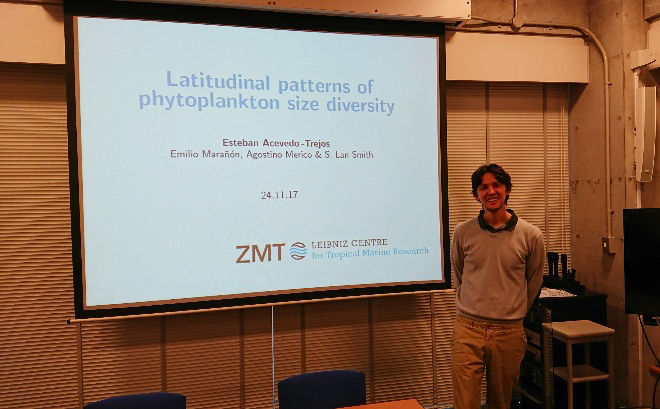
Nov 9, 2017
S. Lan Smith, Bingzhang Chen, Sergio M. Vallina
"Trait-based Modeling Reveals How Plankton Biodiversity-Ecosystem Function (BEF) Relationships Depend on Environmental Variability"
Abstract
Biodiversity-Ecosystem Function (BEF) relationships, which are most commonly quantified in terms of productivity or total biomass yield, are known to depend on the timescale of the experiment or field study, both for terrestrial plants and phytoplankton, which have each been widely studied as model ecosystems. Although many BEF relationships are positive (i.e., increasing biodiversity enhances function), in some cases there is an optimal intermediate diversity level (i.e., a uni-modal relationship), and in other cases productivity decreases with certain measures of biodiversity. These differences in BEF relationships cannot be reconciled merely by differences in the timescale of experiments. We will present results from simulation experiments applying recently developed trait-based models of phytoplankton communities and ecosystems, using the ‘adaptive dynamics’ framework to represent continuous distributions of size and other key functional traits. Controlled simulation experiments were conducted with different levels of phytoplankton size-diversity, which through trait-size correlations implicitly represents functional-diversity. One recent study applied a theoretical box model for idealized simulations at different frequencies of disturbance. This revealed how the shapes of BEF relationships depend systematically on the frequency of disturbance and associated nutrient supply. We will also present more recent results obtained using a trait-based plankton ecosystem model embedded in a three-dimensional ocean model applied to the North Pacific. This reveals essentially the same pattern in a spatially explicit model with more realistic environmental forcing. In the relatively more variable subarctic, productivity tends to increase with the size (and hence functional) diversity of phytoplankton, whereas productivity tends to decrease slightly with increasing size-diversity in the relatively calm subtropics. Continuous trait-based models can capture essential features of BEF relationships, while requiring far fewer calculations compared to typical plankton diversity models that explicitly simulate a great many idealized species.
Katsunori Kimoto
"PETM - An ancient ocean acidification and its influences on marine calcifiers"
Oct. 27, 2017
Minoru Kitamura
"Grazing pressure of Arctic zooplankton"
Abstract
To discuss impact of the decadal zooplankton increase in the Chukchi Sea, changes of potential grazing pressure by zooplankton community during the study period (2000-2003 and 2010-2013) is estimated. Firstly, we estimate abundance and mean body weight of zooplankton. Then, respiration rate of a zooplankton as a function of the body weight and water temperature is calculated. The food requirement of zooplankton can be estimated by using theoretical model based on the respiration rate. And finally, potential grazing pressure of zooplankton community is estimated from comparison between satellite-derived primary productivity and the food requirement. From 2000s to 2010s, the estimated potential grazing pressures by zooplankton in 0-100 m water column increased from 46 to 56% in late July, from 31-58 to 53-97% in early August, and from 47-90 to 92-exceeded 100% in late August.
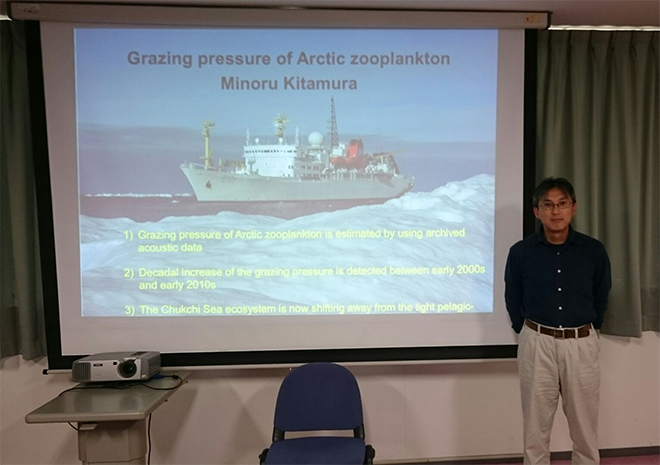
Taketo Hashioka
"Toward a development of a new N2 fixation model based on wide area observations in the North Pacific"
Abstract
N2 fixation is the largest external influx process of nitrogen from the atmosphere to the ocean, but the observation based global estimation still has large uncertainties. As a results, several different approaches have been proposed to model the N2 fixation process, and only few earth system models have explicitly introduced the N2 fixation process. In this study, we re-estimated the global distribution of N2 fixation based on a new observational data of the Pacific, and based on our new estimation we have been developing a new N2 fixation model. Our new global estimation showed significantly different spatial pattern of N2 fixation in the North Pacific compared with previous studies. This result suggests a possibility of overestimation of global N2 fixation rate in previous studies.
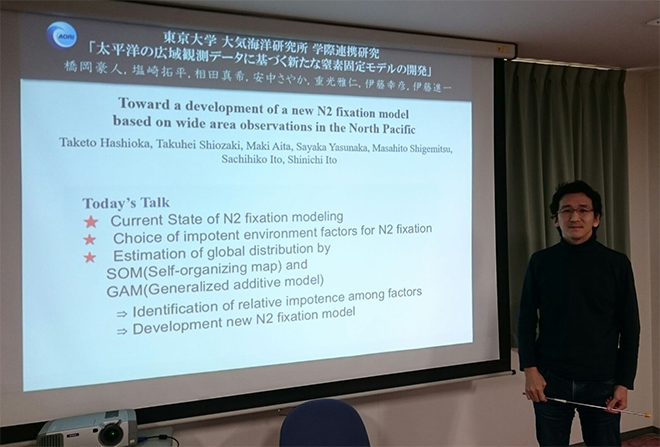
Oct 6, 2017
Kana Nagashima
"High potential of the SEM-cathodoluminescence analysis to the sedimentary and biogeoscience researches: applications to single quartz grains and diatom-frustule"
Abstract
Cathodoluminescence (CL) is the fluorescence induced by electron beam irradiation. We have developed CL spectroscopy to identify provenance area of Asian dust by applying CL to the single quartz grains because CL spectra of quartz represent crystal-chemical features in quartz such as impurities and intrinsic imperfections that depend on the conditions affecting quartz from its formation onward. The statistical evaluation of CL spectra from single quartz grains could discriminate quartz grains from the Taklimakan Desert in northwestern China and the Gobi Desert in southern Mongolia (Nagashima et al., 2017, Geology) .
This new method will have wide utility for future studies in discrimination of sedimentary provenance by focusing on small quantity of quartz, the major mineral in the crust of the Earth.
Moreover, the method could attribute to the bio-geoscience field by applying to the diatom-frustule, because CL spectroscopy also records defects and impurities in amorphous opal, which probably (at least partly...) record surrounding marine-nutrient condition.
Yoshikazu Sasai
"Phytoplankton flexibility impact on modeled primary production in the North Pacific "
Sep 22, 2017
Eko Siswanto
"Bay of Bengal chlorophyll-a variation: Possible impacts of river discharge and atmospheric deposition"
Abstract
The Bay of Bengal (BoB) largely receives terrigenous nutrients via river discharge and atmospheric deposition. In this presentation, preliminary results regarding the impact of nutrient inputs from both sources on the variability of phytoplankton biomass (CHL) in the BoB will be introduced. Satellite-retrieved CHL, aerosol optical thickness (AOT), and rain rate (RR), SPRINTARS model-based dust deposition (DD), and in-situ Ganges-Brahmaputra River (GBR) discharge data within the period from 1997 to 2015 were used for analysis. Further offshore CHL maxima in summer were observed when RR and GBR discharge were high such as in the years 1998, 2007, and 2011, indicating interannual variability attributed to nutrient input from GBR. Regression analysis was conducted to assess whether atmospheric aerosols have an impact on the BoB CHL. Results show that CHL positively responded to DD, but negatively to AOT. The possible impact of climate variability on the BoB CHL especially related RR and GBR discharge variations will be discussed.
Sep 8, 2017
Sergio Vallina (Gijon Oceanography Centre (IEO), Spanish Institute of Oceanography)
"A continuous-trait approximation with adaptive dynamics for modelling phytoplankton size-diversity"
Abstract
Size diversity is thought to be an important determinant of ecosystem functioning. However it remains unclear which mechanisms underlie the observed variations in this type of Biodiversity-Ecosystem Function (BEF) relationships. We developed a continuous trait-distribution model for phytoplankton size distributions that simulate a community of gleaners (smaller sizes) competing with opportunists (larger sizes). The ecosystem is a Nutrient-Phytoplankton-Zooplankton- Detritus (NPZD) model where the size distribution of phytoplankton species is resolved using continuous moment-closure functions. The model is coupled to a simple one-dimensional (1D) depth-resolved physical framework with turbulent diffusion. We tested three scenarios to sustain phytoplankton diversity in the model: 1) trait diffusion (TDF), which is an endogenous mechanism that cause traits to vary through subsequent generations via mutation or trans-generational phenotypic plasticity; 2) Killing-the-Winner (KTW) grazing, which is an exogenous top-down mechanism that enhances diversity via predator-mediated coexistence; 3) a gleaner-opportunist trade-off without TDF or KTW (control scenario), which is an exogenous bottom-up mechanism that allows changes in the mean phytoplankton size via shifts in optimal strategy without enhancing diversity locally. We compared the results of the continuous-size approximation against a classical discrete-size model (e.g. MIT-darwin type) to evaluate the validity of the moment-closure functions to model phytoplankton size distributions. We find that the continuous approximation 1) works very well for the KTW simulation; 2) works less well for the TDF simulation; 3) does not work for the no KTW or TDF (control) simulation. Regarding BEF we find that the Productivity Diversity Relationships (PDR) are positive with size diversity due to changes of community mean size, not to changes in local (i.e. alfa) diversity per-se. These shifts in both community mean size and productivity following seasonal environmental forcing may have important implications for the role of phytoplankton size-diversity in sustaining higher trophic levels in aquatic ecosystems.
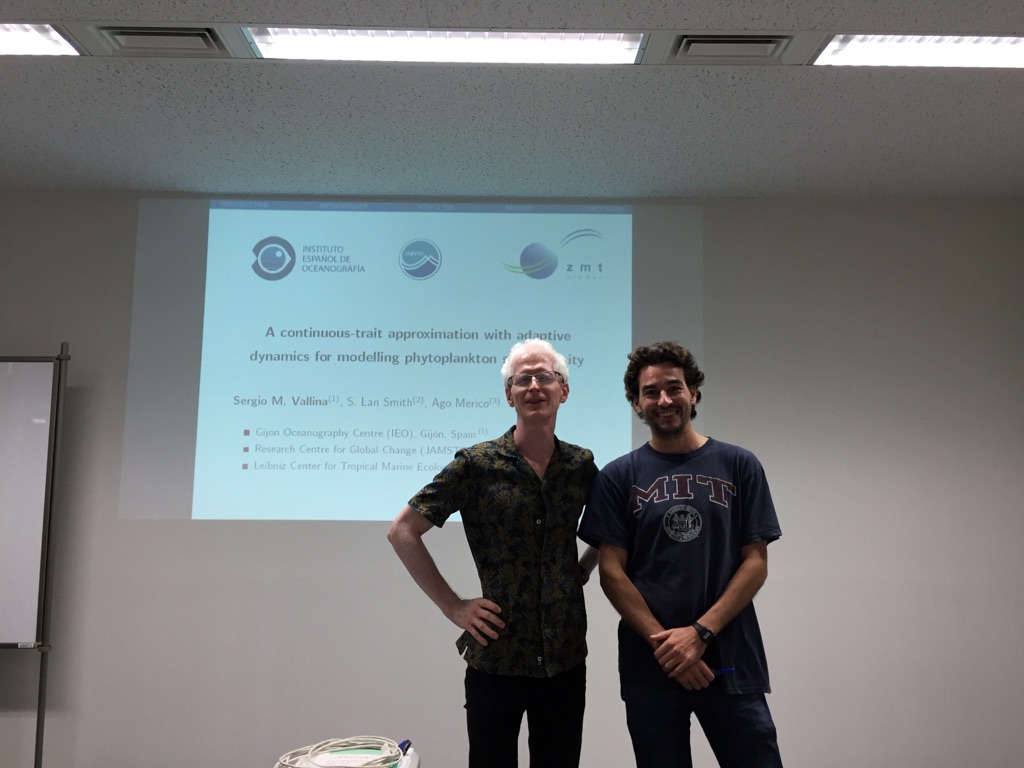
Aug 8, 2017
Yoshio Masuda, Yasuhiro Yamanaka (Hokkaido University)
"Next generation phytoplankton model – introduction of acclimation and size diversity
"
Abstract
Oceanic phytoplankton is a significant component in the oceanic ecosystem and biogeochemical cycles, and numerical models are a useful research tool. Recently, Smith et al. (2015) proposed a phytoplankton size model including acclimation processes. In traditional PFT (Phytoplankton Functional Type) models, size diversity and acclimation are only partially represented. Based on Smith’s model, we developed a phytoplankton model composed by 12 size classes, and connected it a global ocean model. Simulated surface and vertical chlorophyll distributions are in good agreement with observed data. Different from previous models, the depth of the subsurface chlorophyll maximum in the subtropical region is located around 110 m, which is close to the observation. At a subsurface layer, where light is insufficient and nutrient is replete, acclimation in Smith’s model causes increase in chlorophyll content in a cell, and enables phytoplankton growth. For size diversity, the simulated relative contribution of chlorophyll biomass for pico, nano, micro phytoplankton is comparable with satellite-based estimation (Hirata et al. 2011). In comparison with observed S1 data, the vertical profiles of chlorophyll and primary production show good agreement.
Jun 23, 2017
Megumi Chikamoto
"Climate-ecosystem linkage in the North Pacific"
Abstract
Pacific decadal Oscillation (PDO) plays an important role for marine ecosystem variability in the North Pacific. A historical change in fish populations is coherent with PDO, which is indicative of the climate-ecosystem linkage on decadal timescales. At the same time, however, the Aleutian Low variability can also generate high-frequency fluctuations in marine ecosystems. Combination of these high and low-frequency components makes hard to understand the mechanisms of climate-driven ecosystem variability in the North Pacific. In this presentation, I will talk about the mechanisms of comprehensive ecosystem functions associated with climate variability; and discuss the long-term ecosystem memory. This result provides new insights on ecosystem predictability. Furthermore, I will briefly introduce our recent approach of marine reconstructions in the last half of century using a model-data synthesis.
Jun 2, 2017
Jonaotaro Onodera
"Monitoring of shelf material transportation in the northern off Barrow Canyon, Arctic Ocean"
Abstract
Lateral transportation of heat and materials from shelf to basin is important keys to understand ecosystem and biogeochemical cycles in the southwestern Canada Basin. The physical oceanographic model suggested that the westward advection of oceanic eddies from off the Barrow Canyon contributed to the temporal increase of high settling particle flux at Station NAP (75°N 165°W) in the southern Northwind Abyssal Plain. To monitor the shelf-basin interaction in upper stream area of Station NAP, bottom-tethered mooring with sediment trap and hydrographic sensors were deployed off the Barrow Canyon (Station NBC15t, 72.47°N 155.41°W) from October 2015 to September 2016. The trapped particles taken by time-series sediment trap contained abundant lithogenic matters. Total mass flux was one order higher than that at Station NAP. The comparison of settling particle flux and hydrographic sensor data suggests that shelf material component of trapped particles in October 2015 are explained by intensified lateral water current in Pacific summer water. The high flux of settling particles in May-June 2016 is explained by seasonal increase of biological production and intensified water current containing abundant particulate matters in deeper layer of Pacific winter water.
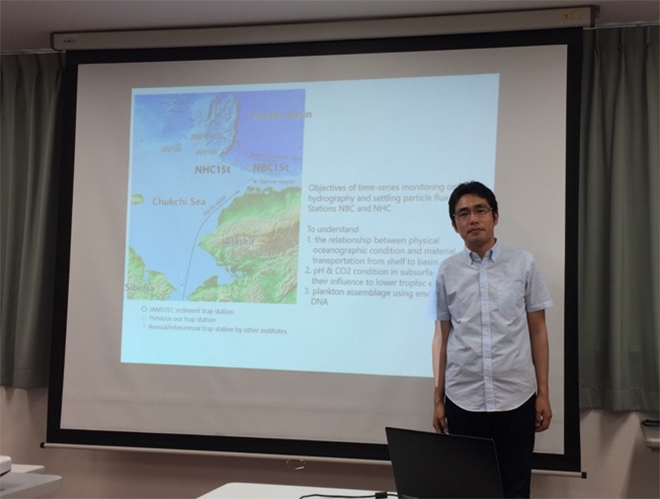
Takuhei Shiozaki
"Significant decrease in nitrification by Arctic environment changes and its impact on the nitrogen cycling"
Abstract
The Arctic Ocean is experiencing rapid environment changes such as sea-ice loss and acidification. Nitrification is the process by which ammonium is converted to nitrite and then to nitrate by specialized prokaryotic microorganisms, and plays a central role on nitrogen cycling between input from nitrogen fixation and output by denitrification. Therefore, change in nitrification rate could alter marine nitrogen cycle. However, the impact of the environment (light and pH) changes on nitrification has rarely examined in the Arctic Ocean. The present study performed light and pH control experiments in the Chukchi Sea, western Arctic Ocean in autumn in 2015 and 2016. The light control experiments showed that ammonia oxidation rates always significantly decreased when the samples were exposed to sunlight. In the pH control experiments, ammonia oxidation rates significantly declined when pH became 0.228 lower than the controls. In the same cruises, we examined in-situ ammonia oxidation rate in the shelf (bottom depth >100 m) and off-shelf regions of Chukchi Sea. In both regions, maximum ammonia oxidation in the upper 100 m in 2016 was significantly lower than in 2015. While the light attenuation coefficient in 2016 was comparable with in 2015, daily surface light intensity in 2016 was significantly higher than in 2015, suggested that microbes in the water column experienced higher light level in 2016. At the depth of ammonia oxidation maximum, the temperature and pH was not significantly changed between 2015 and 2016. Correctively, the lower ammonia oxidation in 2016 was attributable to higher light intensity. Interestingly, ammonium concentration at the ammonia oxidation maximum was elevated in 2016 compared to in 2015. These results may indicate that the decline of nitrification caused the ammonium accumulation in 2016 in the Arctic Ocean.
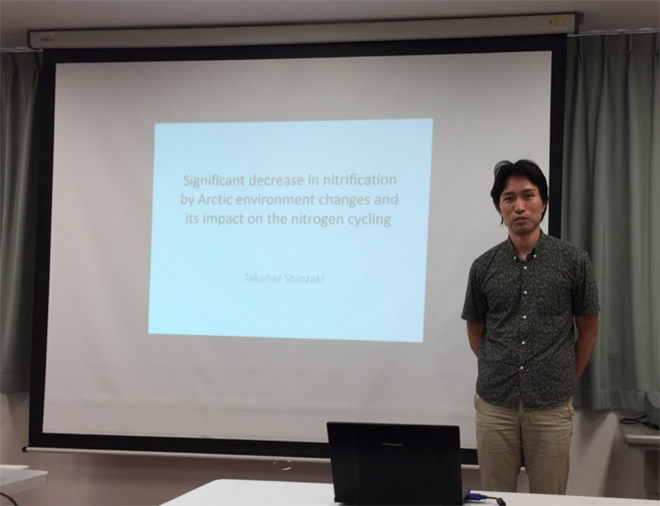
May 19, 2017
Maki Noguchi
"Development of a global marine ecosystem model including the Arctic Ocean: COCO4.9-NEMURO"
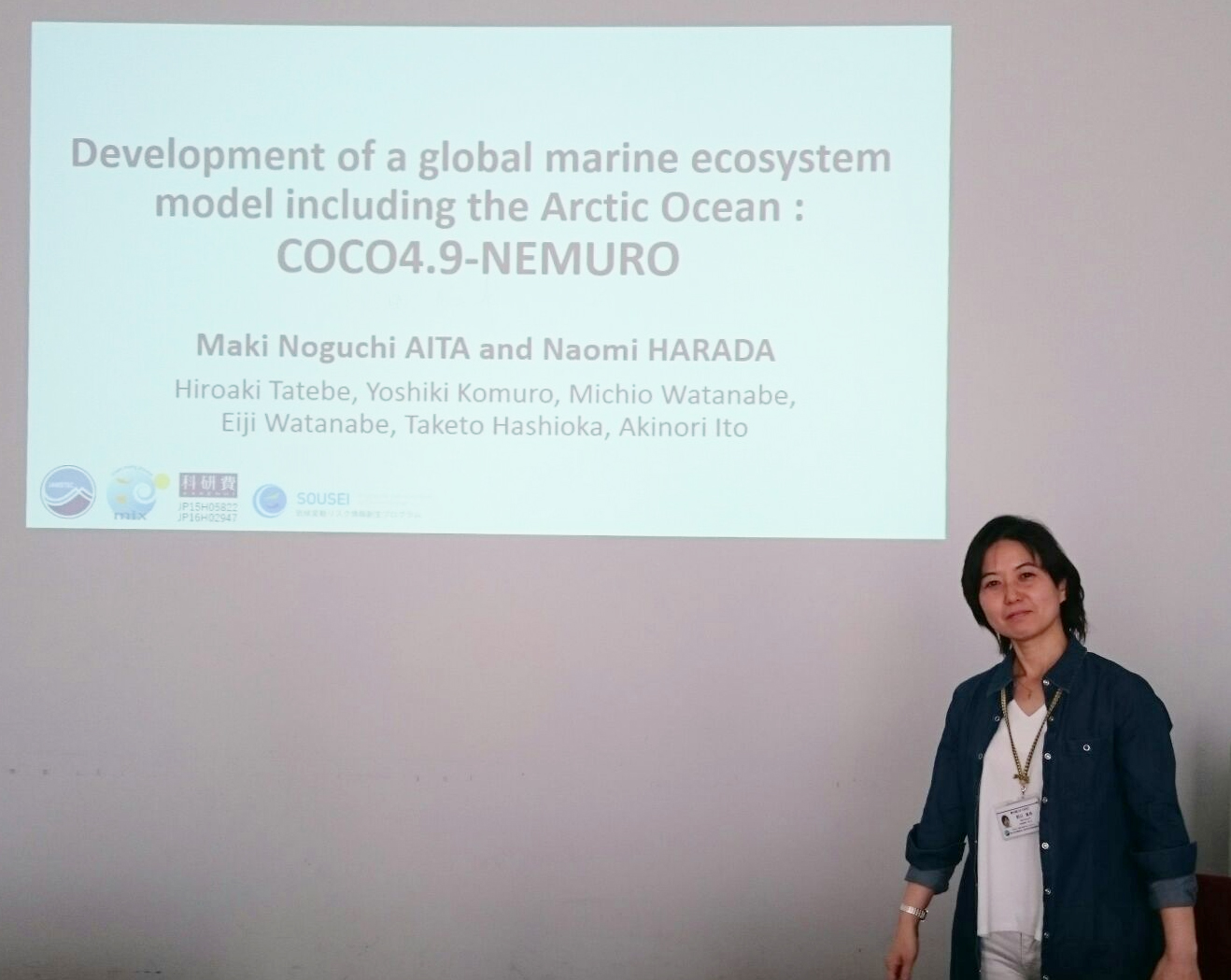
Naomi Harada
"Change in primary production and its complex mechanism in the North Pacific"
Abstract
The KAKENHI project entitled "Ocean Mixing Processes: Impact on Biogeochemistry, Climate and Ecosystem (OMIX)" was started in 2015 as a grant in aid for Scientific Research on Innovative Areas. The purpose of this research project is to quantify the maintenance mechanism of deep and bio-geochemical circulations developing efficient observing system of ocean diapycnal mixing and next generation numerical models. In OMIX, our group will contribute to understand mechanisms to promote primary production via ocean mixing and nutrient supply by physico-chemical processes. The aims of this study is 1) to understand how primary and secondary producers response on the several potential nutrient supply processes associated with physical mechanisms such as atmospheric dynamics, vertical mixing and ocean current in the western North Pacific at where the most active biological drawdown of sea surface pCO2 area works in the world; 2) to clarify the controlling factor in terms of specific nutrient supply and lower trophic level organisms production from sub-tropical to sub-arctic North Pacific. In this presentation, I will show some main results obtained during the last two years.
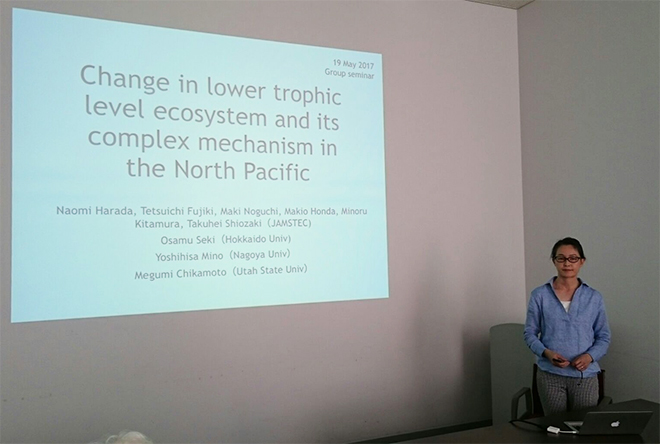
Apr 28, 2017
Erina Shima
"Observations on the internal structure of pteropod shells using a MXCT"
Abstract
Internal structure observations of pteropod shells were made using a MXCT (Micro-focus X-ray Computed Tomography). Pteropods (Limacina retroversa) were collected using sediment traps at 70, 780,1750 and 2820 m in the Antarctic Ocean in 2011. The high resolution CT image with multiple cross-sections can show 3-D structures of the shell. The change of the shell thickness with the increase of circumferential shell length was measured in three growth stages (veliger, juvenile and adult). Generally, the shell thickness increased with the circumferential shell length, and the shell thickness of juvenile stages at 70 m (2.8~5.0 μm) was thinner than those at 780 m (7.4~8.6 μm) and 2820 m (11.7~19.0 μm). Damaged regions at the inner surface of shells collected at 70m were recognized, although there was no marked damage on the shell surface collected in deep layers probably associated with acidified seawater.
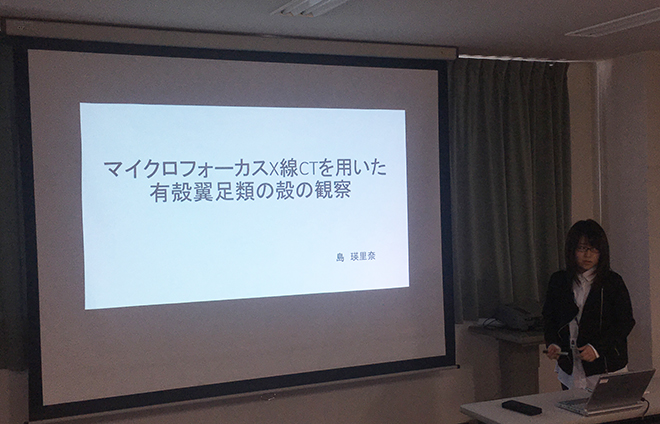
Hajime Kimura
"International Law as “Law”?: The International Legal Frameworks Governing the Arctic Region"
Abstract
“Almost all nations observe almost all principles of international law and almost all their obligations almost all of the time.” International society is no exception to the ancient saying of ubi societas, ibi ius: where there is society, there is law. But little thought is given to the system of international law until it ceases to work satisfactory. What can international law do? Why should Sates comply with international law? The State needs international law, because no State acting alone can achieve what it wants to do or no State acting alone can cope with global environmental problems. International co-operation is indispensable; and co-operation needs a framework. International law is the framework within which international co-operation takes place.
The environmental changes occurring in the Arctic are both substantial and rapid. In spite of these apparent changes, on May 2008, the five coastal States declared: the existing “framework provides a solid foundation for responsible management by the five coastal States and other users of this Ocean through national implementation and application of relevant provisions. We therefore see no need to develop a new comprehensive international legal regime to govern the Arctic Ocean.” In this short presentation, I’ll try to explain briefly how the international legal system operates in the Arctic.
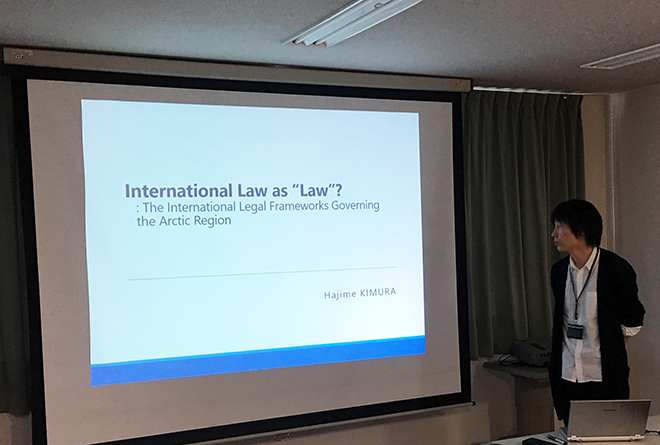
Apr 14, 2017
Bingzhang Chen, S. Lan Smith
"Phytoplankton as a Complex Adaptive System: insights from the “adaptive dynamics” modeling approach"
Abstract
The general features of marine plankton community are well consistent with the definitions of “Complex Adaptive Systems” (CAS), in that it has sustained diversity, local interactions, and autonomous selection forces (Levin 1998). The adaptive dynamics modeling approach, which focuses on the macroscopic properties of the system instead of modeling individual species, describes the key features of the CAS in terms of concise and elegant mathematic equations. We will describe some of the modeling results of the phytoplankton community in the North Pacific using this approach and highlight several insights that are particularly relevant with the relationship between biodiversity and ecosystem functioning (BEF): 1) The interactions between productivity and diversity are bidirectional and both of them are strongly structured by the abiotic environment; 2) The effects of diversity on productivity can have both negative and positive effects; 3) Diversity is not expected to necessarily correlate with productivity because diversity is an emergent pattern of standing stock which is contingent on historical events, while productivity strongly depends on the “current” environmental condition.
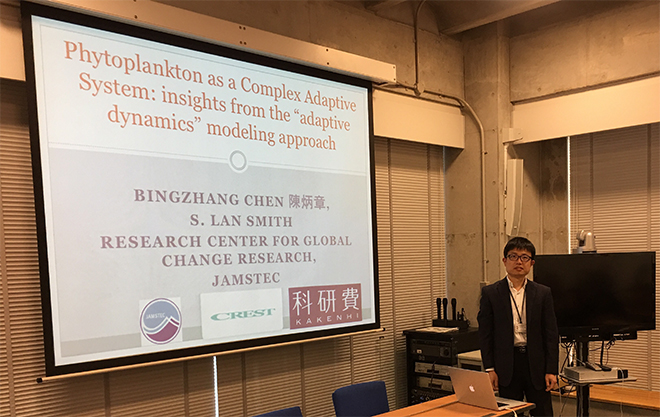
Shinya Iwasaki
"Impact of seawater condition on calcification by marine organisms: 3-D physical measurement based on X-ray micro CT"
Abstract
Discharged anthropogenic CO2 gas has been accumulating in the oceans, lowering seawater pH (ocean acidification), and could reduce calcification rate of marine calcareous organism. In order to monitor and evaluate the impact on calcareous organisms by ocean acidification, several proxies of calcification intensity of planktic foraminifera based on test weight have been employed, whereas these proxies are controlled by several factors other than seawater carbonate chemistry. Here I employ 3-D physical measurement by X-ray micro CT scanner into living Globigerina bulloides (planktic foraminifera) test, evaluate test characteristics (wall thickness, density and calcification rate), and compared them with ambient seawater conditions for the first time. As a result, seawater carbonate saturation state (ΩCa) has the most significant correlation with test density. Furthermore, traditional proxy of calcification intensity, based on the test weight measurement, is not controlled by test density but by calcification rate and wall thickness, indicating that these traditional proxies are not suitable to evaluate the impact on living G. bulloides calcification from ocean acidification.
In this presentation, in addition, I would like to show the results of the study using coral primary polyp skeleton (Acropora digitifera) that were cultured at various temperature and pCO2 levels (temperature 27, 29, 33°C; pCO2 400, 800, 1000 matm). 3-D morphological measurements made by X-ray micro CT also show that physical characteristics of coral skeleton differ depending on water conditions. These results indicate that 3-D physical measurement by X-ray micro CT must be a powerful tool to investigate impact on calcification of marine organisms due to various environmental stresses.
